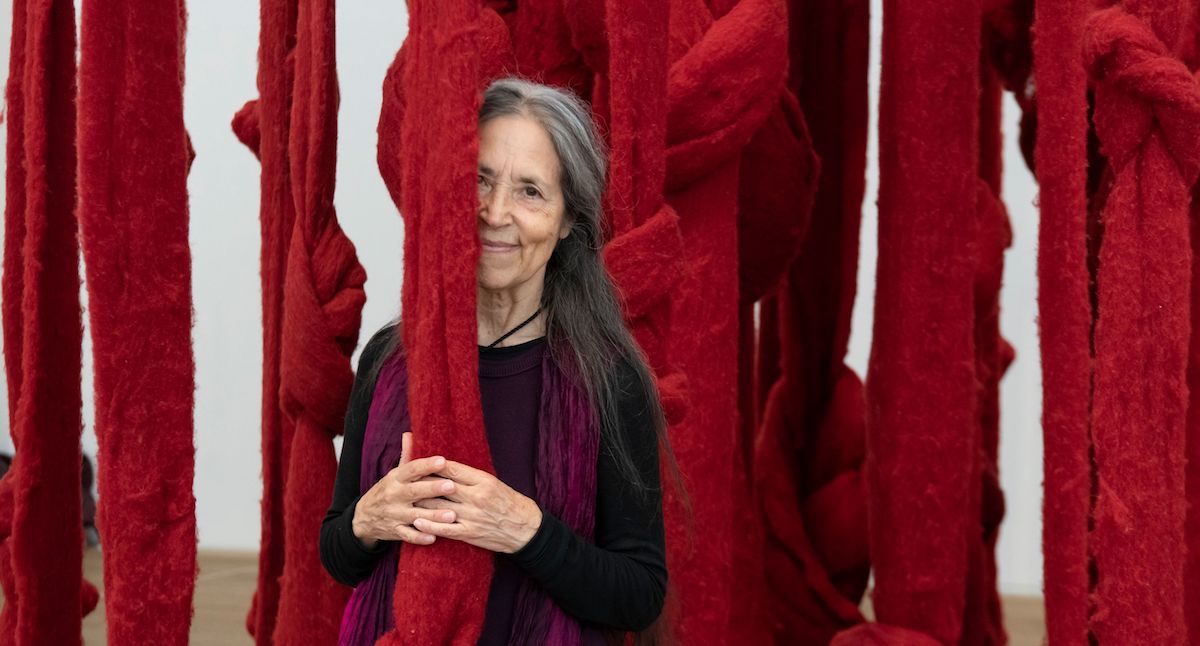Tate Modern has unveiled two new monumental sculptures created by the Chilean artist/poet Cecilia Vicuña.
The artworks are woven together from various materials; they hang 27 metres from the ceiling and are positioned at opposite ends of the Turbine Hall. These sculptures are combined with audio and digital installations to form Vicuña’s most ambitious work.
Brain Forest Quipu is the seventh annual Hyundai Commission for the Turbine Hall, made possible by the ongoing partnership between Tate and Hyundai Motor. The installation combines different strands of Cecilia Vicuña’s practice: her use of found materials to create delicate sculptural forms, her excellent work, her activism for Indigenous peoples and environmental causes, and her pioneering work with the Andean tradition of the quipu. Describing this tradition, Vicuña writes: ‘In the Andes, people did not write. Instead, they wove meaning into textiles and knotted cords. Then, five thousand years ago, they created the quipu, a poem in space, a way to remember, involving the body and the cosmos at once. A tactile, spatial metaphor for the union of all.’

A multi-part installation is an act of mourning for the destruction of forests, the subsequent impact of climate change, and the violence against Indigenous people. The pale, bone-white quipu sculptures in the Turbine Hall contain various materials, including unspun wool, plant fibres, rope and cardboard. These are interspersed with found objects like small clay pipes and pottery fragments, which were collected from the banks of the Thames by women from local Latin American communities. The ghostly skeletal forms of these quipus stand for the dead forests and embody the sheer forces of the ecosystem. At the same time, their textures and colours evoke the bleached tree bark of woods killed by drought or intentional fire, as well as other dried-out natural substances like bone and snakeskin. Their interwoven structures also suggest deeper connections between the personal and the universal, from the mysterious grey matter of our brains to the awesome cosmology of deep time and outer space. Vicuña writes: “the Earth is a brain forest, and the quipu embraces all its interconnections.”
A soundscape titled the ‘Sound Quipu’ is played from speakers within each sculpture. Vicuña worked with composer Ricardo Gallo on the collection of compositions woven together from new improvised recordings by Vicuña, Gallo and other artists, traditional Indigenous music, field recordings of nature, and periods of contemplative silence. This ‘Sound Quipu’ is joined by a ‘Digital Quipu’, created from the videos of Indigenous activists and land defenders, shown under the Turbine Hall bridge and on screens found on concourses throughout Tate Modern, as well as online.
Finally, a ‘Quipu of Encounters: Rituals and Assemblies’ brings together artists, activists, scientists, poets and defenders of forests worldwide in a collective ritual that will take place at Tate on the afternoon of Friday, 14 October. Through a series of events, the ‘Quipu of Encounters’ invites visitors to become active in preventing climate catastrophe. These networks continue a process that began at Vicuña’s Spin Spin Triangulaire at the Guggenheim Museum and will continue in other locations worldwide.
Hyundai Commission: Cecilia Vicuña is curated by Catherine Wood, Director of Programme and Fiontán Moran, Assistant Curator, International Art, with Helen O’Malley Curator, Community Programmes, Tate Modern. A new book from Tate Publishing will accompany it.
Top Photo: Top Photo Courtesy Tate Press

